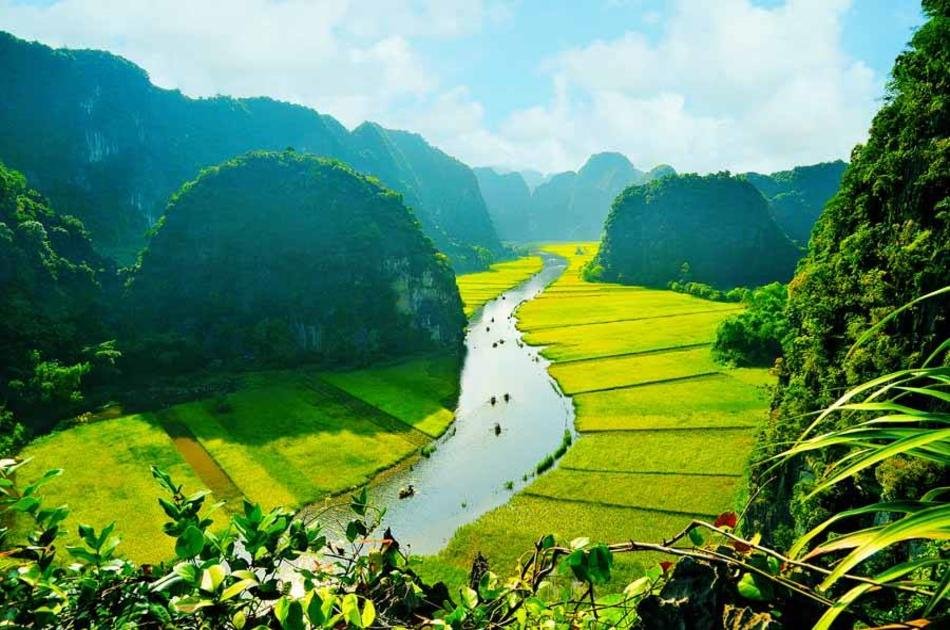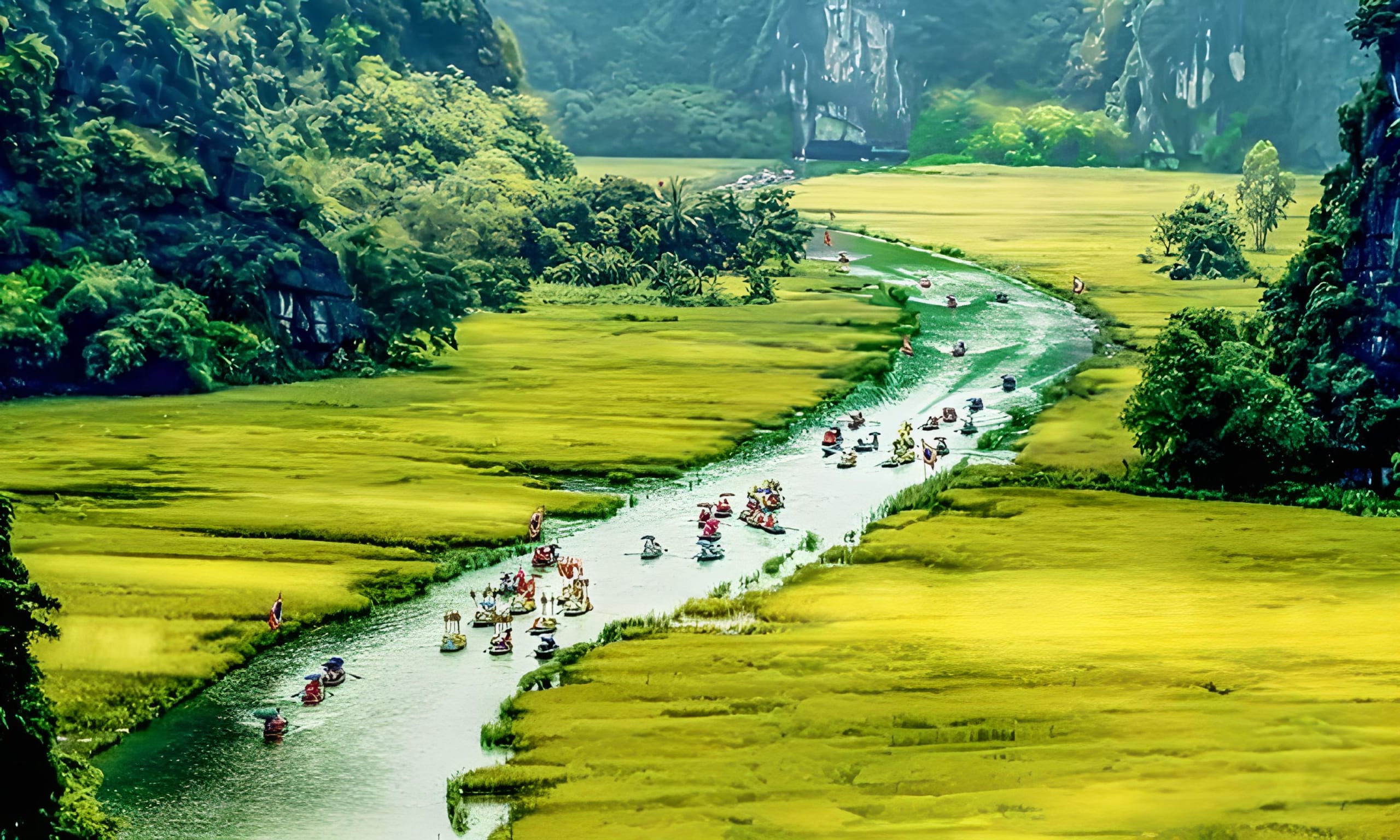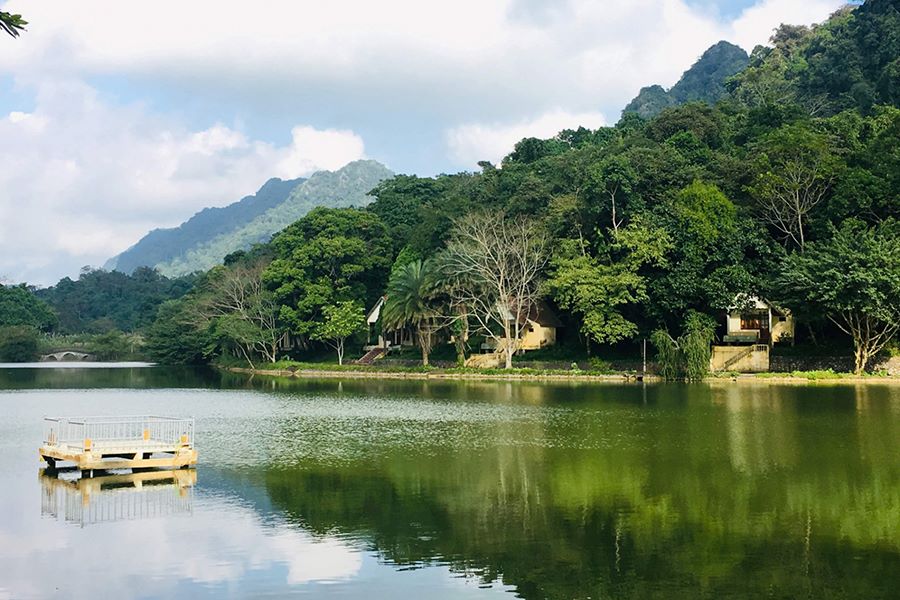
Cuc Phuong National Park Ninh Binh: What to explore?
Cuc Phuong National Park Ninh Binh is a fantastic destination for those looking to immerse themselves in Vietnam’s natural beauty and contribute to conservation efforts. It offers a different kind of experience than the popular boat trips of Tam Coc or Trang An, focusing more on active exploration and wildlife.

Cuc Phuong National Park Ninh Binh
Cuc Phuong National Park Ninh Binh, located in Ninh Binh Province, is Vietnam’s oldest and largest national park, renowned for its rich biodiversity and ancient rainforest.
Location of Cuc Phuong National Park Ninh Binh:
Cuc Phuong National Park Ninh Binh spans across three provinces: Ninh Binh, Hoa Binh, and Thanh Hoa. Its main entrance and visitor center are located in Nho Quan District, Ninh Binh Province, approximately 45km southwest of Ninh Binh City and around 120-140km south of Hanoi. It’s often visited as a day trip or an overnight stay from Ninh Binh or even Hanoi.
Highlights of Cuc Phuong National Park Ninh Binh:

- Ancient Rainforest & Biodiversity: Home to an incredibly diverse ecosystem with over 2,000 species of plants, 307 species of birds, 133 species of mammals, and numerous reptiles and amphibians. You can trek through dense jungle, observe towering ancient trees (like the 1,000-year-old tree and the Dang tree), and experience the sounds of the wilderness.
- Endangered Primate Rescue Center (EPRC): A significant conservation effort, this center rehabilitates and breeds critically endangered primates, especially various langur species (like the Douc Langur). Visitors can see these rare animals and learn about conservation efforts. It’s a key reason many people visit the park.
- Turtle Conservation Center: Another important facility dedicated to protecting and breeding endangered turtle species.
- Prehistoric Caves: Several caves within the park (e.g., Cave of Prehistoric Man, Con Moong Cave) contain evidence of ancient human habitation dating back thousands of years, offering archaeological insights.
- Night Wildlife Spotting: The park offers guided night tours where you can spot nocturnal animals like civets, flying squirrels, and lorises (though sightings are not guaranteed).
- Butterfly Season (April-May): If you visit during late spring/early summer, you might witness thousands of butterflies fluttering, creating a magical spectacle.
- Trekking and Cycling: Numerous well-marked trails cater to different fitness levels, from short walks to multi-hour treks and even overnight excursions. Cycling along the paved roads within the park is also a popular way to explore.
- Muong Ethnic Villages: Opportunities to learn about the local Muong ethnic minority’s culture and traditions, sometimes offering homestay experiences.
Lowlights of Cuc Phuong National Park Ninh Binh:
- Mosquitoes & Leeches: Especially during the wet season (May to October), mosquitoes are abundant, and leeches can be a concern on trekking trails. Proper repellent and clothing are essential.
- Hot and Humid (Wet Season): The park can be extremely hot and humid during the summer months, making long treks more challenging. Trails can also be muddy and slippery during heavy rains.
- Limited Public Transport: Getting to the park, especially from Ninh Binh City, often requires a taxi, private car, or motorbike rental, as local buses are not always direct or convenient.
- Wildlife Sightings Not Guaranteed: While the park is rich in wildlife, actually spotting rare animals in the dense jungle can be difficult and requires patience and luck, particularly during the day.
- Basic Accommodation: Lodging options within or very near the park are often rustic and basic, appealing more to nature enthusiasts than luxury travelers.
Price Range:
- Entrance Fee: Approximately 60,000 VND per adult. (Students and children often have reduced fees).
- Additional Costs:
- Motorbike rental: If you rent one in Ninh Binh to get there (~100,000 – 150,000 VND/day).
- Electric car rental (within park): If you don’t have your own vehicle, you’ll need to pay for an electric car to get deeper into the park from the main entrance (fares vary depending on distance).
- Conservation Centers: A small additional fee may be charged for entry to the Endangered Primate Rescue Center (e.g., 50,000 VND).
- Guided tours: For treks or night spotting, a guide fee will apply (negotiable or fixed by the park).
- Accommodation: Basic rooms or dorms within or near the park start from around 200,000 – 400,000 VND/night, going up for more comfortable options.
- Food & Drinks: Available at the visitor center area.
Customer Review:

Customer reviews are generally very positive, especially from those who appreciate nature and conservation.
- Positives: Visitors rave about the lush, ancient rainforest, the unique experience of seeing endangered primates up close, the peaceful atmosphere, and the variety of trekking options. Many highlight the park as a refreshing contrast to the more touristy areas of Ninh Binh. The cleanliness and well-maintained trails are often mentioned.
- Negatives/Considerations: Common complaints revolve around the abundance of mosquitoes (especially during the rainy season), the challenging heat and humidity (again, in wet season), and sometimes the difficulty of independent travel to and within the park without a motorbike or private car. A few reviews mention that wildlife sightings can be limited to the conservation centers, and truly wild animal encounters are rare.
See also: Top places for Vietnamese drinks – must try!
Who’s suitable for Cuc Phuong National Park Ninh Binh?
- Nature Lovers & Ecologically Minded Travelers: Those passionate about biodiversity, conservation, and pristine natural environments.
- Trekkers & Hikers: Offers a range of trails for different fitness levels.
- Families (with older children): The conservation centers (primates, turtles) are educational and engaging for children, but the more strenuous treks might not be suitable for very young kids.
- Birdwatchers & Wildlife Enthusiasts: An excellent spot for observing various species, especially during specific seasons.
- Those seeking an escape from urban bustle: Provides a tranquil and immersive nature experience.
- Adventurous travelers: Open to rustic conditions and outdoor activities.
Tips to enjoy Cuc Phuong National Park Ninh Binh

Cuc Phuong National Park offers a fantastic opportunity to connect with nature and experience Vietnam’s incredible biodiversity. To truly enjoy your visit, here are some essential tips:
1. Timing is Key
- Best Time to Visit (Dry Season): The ideal time to visit Cuc Phuong is during the dry season, from November to April.
- November to February: Offers cooler, drier, and more pleasant weather for trekking. This is generally considered the most comfortable period.
- April to May (Butterfly Season): If you want to witness the spectacular butterfly season, late April to early May is prime. The park comes alive with thousands of colorful butterflies. Be aware that temperatures start to rise during this period, and it can be humid.
- Avoid Rainy Season (May to October): The wet season brings heavy rainfall, high humidity, and an abundance of mosquitoes and leeches. Trails become very muddy and slippery, making trekking challenging and less enjoyable.
2. What to Wear & Bring
- Comfortable Hiking Shoes/Boots: This is paramount. The trails can be uneven, rocky, and slippery, especially after rain. Ditch the flip-flops! Sturdy shoes with good grip and ankle support are essential.
- Long Pants and Long-Sleeved Shirt:
- Protection: Essential for protecting against insect bites (mosquitoes, leeches), scratches from vegetation, and sun exposure.
- Material: Choose lightweight, breathable, moisture-wicking fabrics (like nylon or quick-dry polyester) to stay as comfortable as possible in the humid environment.
- Insect Repellent (with DEET): Crucial, even in the dry season. Apply generously, especially before and during treks.
- Hat and Sunglasses: For sun protection.
- Rain Gear: A lightweight, packable rain jacket or poncho is always a good idea, even during the dry season, as sudden showers can occur.
- Water Bottle: Bring plenty of water, especially for treks. It gets hot and humid, and staying hydrated is vital.
- Snacks: Pack some energy bars, fruits, or other snacks, especially if you plan on longer treks, as food options are limited within the deeper parts of the park.
- Small First-Aid Kit: Include band-aids, antiseptic wipes, pain relievers, and any personal medications. Consider a small bottle of salt or a lighter if you’re particularly worried about leeches (they detach quickly with salt/heat).
- Binoculars: Enhance your wildlife spotting, especially for birds or primates.
- Camera: To capture the stunning scenery and wildlife.
- Flashlight/Headlamp: Absolutely necessary if you plan to do a night tour or if you are trekking late.
- Power Bank/Portable Charger: To keep your phone and camera charged.
3. Getting Around the Park
- Motorbike is King (if confident): Renting a motorbike from Ninh Binh City or Tam Coc offers the most flexibility to explore the park at your own pace. The roads within the park are paved.
- Electric Car/Park Shuttle: From the main entrance/visitor center, you’ll need to pay for an electric car to get deeper into the park where the main trails and ancient trees are located (about 20 km from the entrance). You can ask your driver to wait or arrange a pickup time.
- Hire a Private Car/Taxi: The most comfortable and hassle-free option, especially if traveling with a group or lots of luggage. You can arrange this through your hotel in Ninh Binh.
- Cycling (within the park): Bicycles can be rented at the park entrance or visitor center. It’s a lovely way to explore the paved roads, enjoy the fresh air, and potentially spot some animals.
4. Maximizing Your Experience
- Visit the Conservation Centers First: Start your day by visiting the Endangered Primate Rescue Center and the Turtle Conservation Center near the park entrance. These are highly educational and offer guaranteed sightings of rare animals.
- Choose Your Trek Wisely:
- 1,000-year-old Tree Trail: This is one of the most popular and rewarding treks, usually a 6-7 km loop. It takes you through dense jungle to a massive ancient tree.
- Cave of Prehistoric Man: A shorter, easier walk (around 300 meters) from the roadside.
- May Bac Peak (Silver Cloud Peak): A more challenging, full-day trek (often requiring a guide) that rewards you with panoramic views.
- Consider a Guide: For longer or more challenging treks, or if you want to learn more about the flora and fauna, hire a local park guide. They can point out things you’d otherwise miss and enhance your safety.
- Consider a Night Tour: If staying overnight or able to arrange transport, a guided night wildlife spotting tour is a unique experience. While sightings aren’t guaranteed, hearing the jungle come alive at night is magical, and you might spot civets, lorises, or flying squirrels.
- Stay Overnight (Optional): Staying at the park’s guesthouses or a homestay in a nearby Muong village allows you to experience the park in the early morning and late evening, when wildlife is more active, and participate in night tours. Accommodations are basic but sufficient.
- Manage Expectations for Wild Animal Sightings: While the park is incredibly biodiverse, spotting large wild animals in their natural habitat is rare in dense rainforests. The conservation centers offer the best chance to see endangered species.
- Be Respectful: Stick to marked trails, do not litter, do not disturb wildlife, and respect the local Muong culture if visiting their villages.
